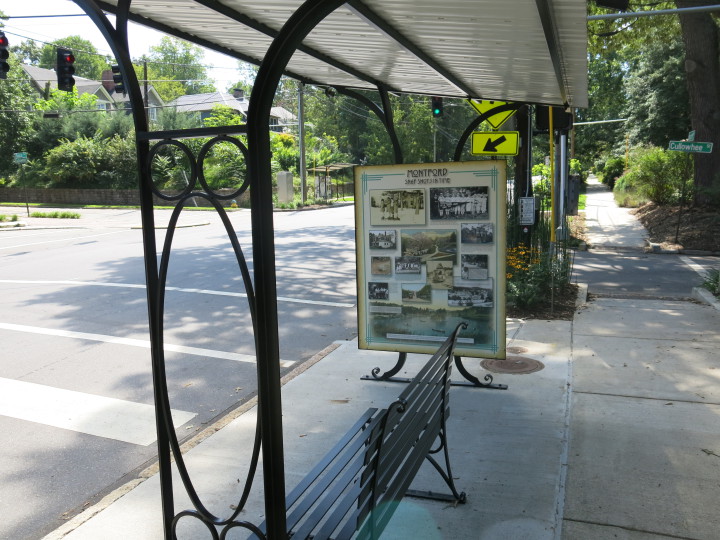In Asheville, history is conveyed in various ways — from the preservation of historic homes, inns and churches, to the citywide use of plaques, statues and sculptures. More recently, two bus shelters on Montford Avenue were added to the community’s overall historical efforts.
The shelters, one serving northbound- and the other southbound-travelers on Montford Avenue at Cullowhee Street, feature doubled-sided panels that provide a look at four aspects of the neighborhood’s history. Sharon Fahrer, who conducted research for the project, says she hopes the panels will highlight the area’s diverse population and “give people a new perspective on Montford.”
The northbound stop provides waiting riders a chance to read about former properties lost to demolition and fire. There are 16 images, along with a map of the area. Included in these photographs are: the Montford Avenue School, which operated from 1892 to 1951; the Torrence Hospital, Asheville’s first African-American clinic; and a rather dramatic image of the fire at Central Building of Highland Hospital in 1948, which killed nine patients, including Zelda Fitzgerald.
The opposite side of the northbound stop’s panel provides a look at Montford’s African-American community, showcasing the wide range of professions held by these community members, from teachers to nurses, ministers to business owners. The panel also highlights notable community members, such as Winfred W. Young, who served in WWII, and Tempe Avery, a midwife, nurse and former slave of Nicholas Woodfin. African-American run institutions and businesses are depicted, as well.

Across the street, the southbound shelter includes images of bygone neighborhood clubs and activities, such as the Montford Avenue Goats (the 1910 YMCA baseball league champions) and the Soap Box Derby, which began in 1946. On its other side, the panel spotlights selected community members, including: Solomon Lipinsky, founder of Bon Marche Department store; Walter Mapp Sr., who worked to educate and integrate the Asheville community; and Sarah Upchurch, who helped create the Montford Historic District.
“It wasn’t an overnight process,” Fahrer says of the project. “It took a lot of people to bring [the project] to fruition.” Michael McDonough designed the structures; Tina Council fabricated the metal. Ross Terry created the panels’ graphics. Photographs were provided by Pack Library’s North Carolina Room and D.H. Ramsey Library Special Collections at UNC Asheville. Additional input and information came from community members Sue Russell, Daphne Young, Lenora Robinson and Roy Harris. The city of Asheville and the Historic Resources Commission were also involved in the project.
“The larger hope is that other neighborhoods will copy this idea and create their own panels about their history,” says Fahrer. “It’s a community-building project — to ask your neighbors for pictures and stories. It’s a great way for the neighborhood to come together.”



Before you comment
The comments section is here to provide a platform for civil dialogue on the issues we face together as a local community. Xpress is committed to offering this platform for all voices, but when the tone of the discussion gets nasty or strays off topic, we believe many people choose not to participate. Xpress editors are determined to moderate comments to ensure a constructive interchange is maintained. All comments judged not to be in keeping with the spirit of civil discourse will be removed and repeat violators will be banned. See here for our terms of service. Thank you for being part of this effort to promote respectful discussion.